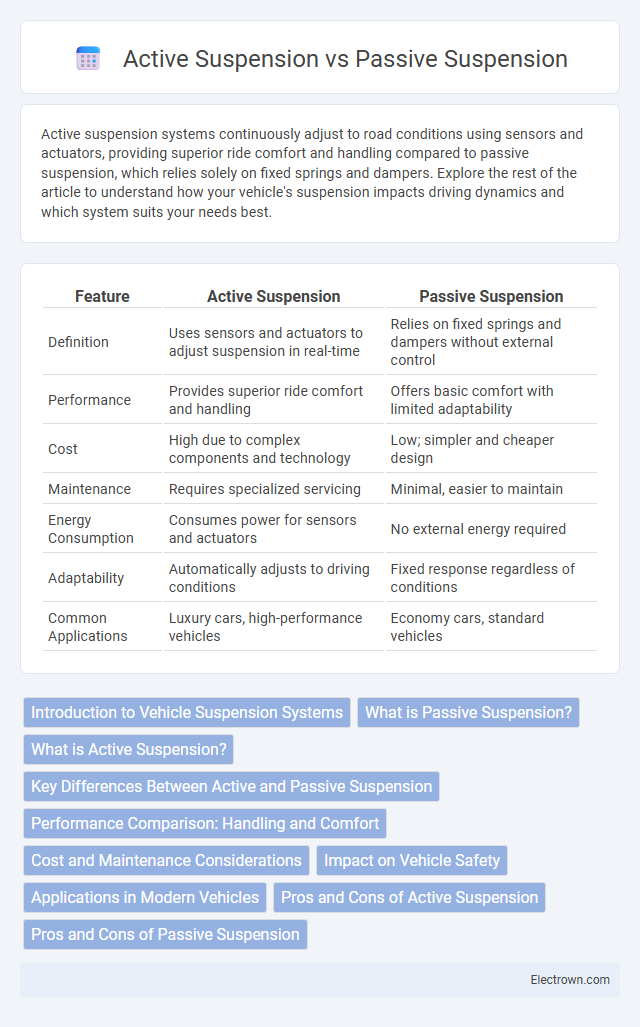Active suspension systems continuously adjust to road conditions using sensors and actuators, providing superior ride comfort and handling compared to passive suspension, which relies solely on fixed springs and dampers. Explore the rest of the article to understand how your vehicle's suspension impacts driving dynamics and which system suits your needs best.
Table of Comparison
| Feature | Active Suspension | Passive Suspension |
|---|---|---|
| Definition | Uses sensors and actuators to adjust suspension in real-time | Relies on fixed springs and dampers without external control |
| Performance | Provides superior ride comfort and handling | Offers basic comfort with limited adaptability |
| Cost | High due to complex components and technology | Low; simpler and cheaper design |
| Maintenance | Requires specialized servicing | Minimal, easier to maintain |
| Energy Consumption | Consumes power for sensors and actuators | No external energy required |
| Adaptability | Automatically adjusts to driving conditions | Fixed response regardless of conditions |
| Common Applications | Luxury cars, high-performance vehicles | Economy cars, standard vehicles |
Introduction to Vehicle Suspension Systems
Vehicle suspension systems are crucial for maintaining ride comfort and handling by absorbing road shocks and vibrations. Active suspension uses sensors and actuators to adjust the suspension dynamically in real-time, enhancing stability and performance on varying terrain. Passive suspension relies on fixed springs and dampers without external input, offering simplicity and reliability but less adaptability to changing road conditions.
What is Passive Suspension?
Passive suspension consists of fixed components such as springs and dampers that absorb and dissipate road shocks without external control or adjustment. It relies on mechanical properties to provide ride comfort and vehicle stability but cannot adapt to changing road conditions in real-time. This type of suspension is simpler, less expensive, and widely used in standard vehicles due to its reliability and ease of maintenance.
What is Active Suspension?
Active suspension uses sensors, actuators, and a control system to continuously adjust the vehicle's suspension in real-time for optimal ride comfort and handling. Unlike passive suspension, which relies on fixed springs and dampers, active suspension adapts dynamically to road conditions, reducing body roll, pitch, and vibration. Your driving experience benefits from enhanced stability and smoother responses to changes in terrain or driving style.
Key Differences Between Active and Passive Suspension
Active suspension systems use sensors and actuators to continuously adjust the suspension for optimal ride comfort and handling, while passive suspension relies on fixed springs and dampers that cannot adapt in real-time. Active suspension improves vehicle stability by actively counteracting road irregularities, whereas passive suspension offers a simpler, cost-effective solution with less precise ride control. Your choice depends on whether you prioritize advanced performance and comfort or durability and lower maintenance costs.
Performance Comparison: Handling and Comfort
Active suspension systems enhance handling by continuously adjusting damping and stiffness based on real-time road conditions, resulting in superior vehicle stability and cornering performance compared to passive suspension. Passive suspension relies on fixed components like springs and dampers, offering limited adaptability, which often compromises comfort and handling, especially on uneven surfaces. The dynamic responsiveness of active suspension significantly improves ride comfort by minimizing vibrations and body roll, outperforming the more rigid and less adaptable passive system.
Cost and Maintenance Considerations
Active suspension systems typically incur higher upfront costs due to complex components and advanced technology, requiring specialized maintenance that can increase long-term expenses. Passive suspension systems offer a more affordable initial price and simpler upkeep, with fewer parts vulnerable to wear and easier repairs. Your choice between active and passive suspension should consider budget constraints and the anticipated cost and frequency of maintenance.
Impact on Vehicle Safety
Active suspension systems enhance vehicle safety by dynamically adjusting to road conditions, improving stability and reducing body roll during sharp turns or sudden maneuvers. Passive suspension relies on fixed components like springs and dampers, offering limited adaptability, which may lead to reduced traction and increased risk of rollover in extreme driving scenarios. Your vehicle's safety significantly benefits from active suspension's ability to maintain optimal tire contact and better control under diverse driving conditions.
Applications in Modern Vehicles
Active suspension systems in modern vehicles utilize sensors and actuators to continuously adjust damping forces, providing superior ride comfort and enhanced handling performance compared to traditional passive suspension. Applications span luxury cars, sports vehicles, and off-road trucks where real-time adaptation to road conditions improves stability, safety, and passenger comfort. Understanding the benefits of active suspension can help you choose a vehicle that maximizes driving dynamics tailored to your specific needs.
Pros and Cons of Active Suspension
Active suspension systems offer enhanced ride comfort and improved vehicle handling by automatically adjusting suspension components in real-time based on road conditions. They provide superior stability and reduce body roll during cornering but come with higher costs, increased complexity, and greater maintenance requirements compared to passive suspension systems. Despite these drawbacks, active suspensions significantly improve driving dynamics and safety, especially in performance and luxury vehicles.
Pros and Cons of Passive Suspension
Passive suspension systems offer simplicity, lower cost, and reduced maintenance compared to active suspension, making them reliable for everyday driving conditions. However, they lack adaptability to varying road surfaces and cannot adjust damping in real-time, leading to a compromise between comfort and handling. You may experience less precise ride control and increased body roll during cornering with passive suspension systems.
Active suspension vs Passive suspension Infographic

 electrown.com
electrown.com